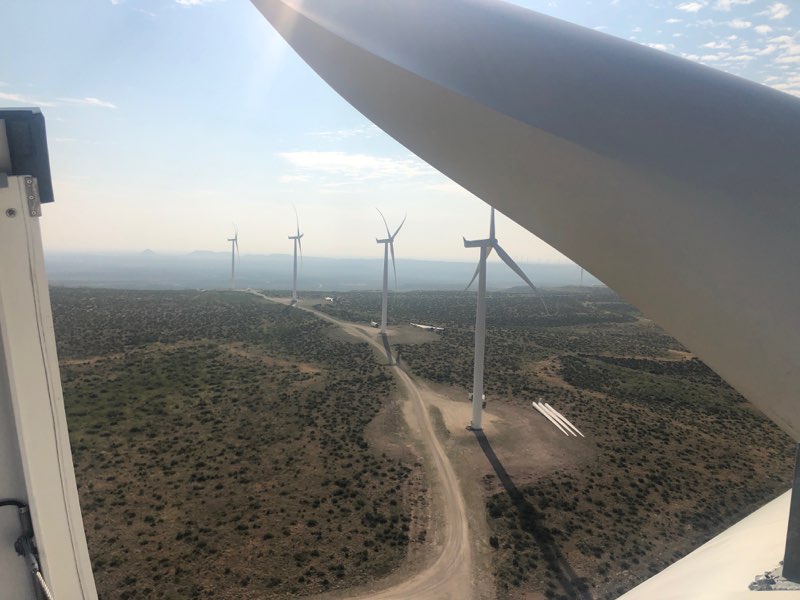Power Hungry? Or just on a low-fact diet?
Over the weekend I had the misfortune of reading Power Hungry by Robert Bryce. Mr. Bryce is a senior fellow at the Manhattan Institute, a Washington think tank that receives a significant amount of funding from the oil and gas industry. Based on the sheer number of incorrect and misleading claims the book makes about wind energy, I had to check the inside cover to make sure that I hadn’t accidentally picked up Mr. Bryce’s previous book, Gusher of Lies, as that was a far more apt title for what I was reading.
Here are the most salient errors and misleading claims in Mr. Bryce’s book:
1. Land use – Mr. Bryce begins with a misleading claim that wind and solar energy require more land than other sources of energy production. Unfortunately, he overstates the actual land use of wind energy by a factor of 20 to 50 by failing to account for the fact that only 2-5% of the land area of a typical wind plant is actually taken up by wind turbines and other equipment, while the remaining 95-98% can continue being used for farming, ranching, or whatever its prior use was. A 2008
report by the U.S. Department of Energy (http://www.20percentwind.org) concluded that obtaining 20% of the nation’s electricity from wind energy would use less land than is currently occupied by the city of Anchorage, Alaska.
Mr. Bryce accompanies this error, and forfeits any claim to objectivity, by drastically understating the land use impacts of other sources of production, ignoring the massive area that must be mined to produce a useable quantity of coal or uranium and the significant amount of land devoted to natural gas pipelines. Moreover, the harmful, and in many cases, irreversible impact on the land caused by the extraction, transportation, and consumption of these other fuels is far greater than the comparatively benign impact of installing wind turbines.
In a sidebar in Chapter 11, Mr. Bryce attacks wind energy for its potential impact on birds. In this passage he cites misleading worst-case statistics and glosses over important facts, like the fact that buildings, house cats, and communication towers would still kill thousands of times more birds per year than wind turbines, even if the U.S. increased wind energy output 10-fold. Mr. Bryce also ignores the far-reaching impacts of conventional electric generating technologies on wildlife, including the
impacts of climate change, fuel mining, and power plant water use.
2. Wind turbine syndrome – Perhaps the most disappointing of Mr. Bryce’s attacks on wind energy is when he jumps on the bandwagon of the cult that believes in the existence of so-called Wind Turbine Syndrome. Spurred by a few anecdotal cases of a person who lives within a few miles of a wind plant developing cancer or another ailment, Wind Turbine Syndrome proponents conclude that the wind turbines must have caused that illness. Despite the lack of any scientific basis for these claims or evidence that the rates of these illnesses are higher near wind plants, Mr. Bryce wholeheartedly embraces the concept. His support for this claim? A single book, self-published last year by the well-known anti-wind activist Nina Pierpont.
3. Emissions – Next, Mr. Bryce takes on the laws of physics, claiming that wind energy does not significantly reduce carbon dioxide emissions. In reality, every amount of electricity produced by a wind or solar power plant must displace an equal amount of electricity produced by another power plant, a fact that is supported by reams of government studies and data showing that as wind energy production goes up, fossil fuel use and carbon emissions go down.
Mr. Bryce tries to evade this overwhelming body of statistics by selectively citing a single misleading example: that Denmark’s CO2 emissions in 2007 were only slightly lower than their emissions in 1990, even though Denmark’s use of wind power has grown substantially since 1999. What Mr. Bryce doesn’t tell you is that Denmark’s CO2 emissions were abnormally low in 1990 because hydroelectric power output was unusually high that year. In fact, a chart he buries on page 111 of his own book–and doesn’t mention at all in the text–shows that Denmark’s electric sector CO2 emissions fell from 44 million tons in 1991 to 23 million tons in 2007, a reduction of nearly 50%, while electricity consumption increased by over 20% during that period.
In the U.S., Department of Energy data for the states of Colorado and Texas (two states with high wind penetrations and relatively isolated power grids) show that emissions of carbon dioxide, sulfur dioxide, and nitrogen oxides have decreased in lockstep as wind energy has been added to the power grid. In fact, the decrease in emissions is often greater than proportional to the increase in wind energy use.
4. Capacity factor versus capacity value – Chapter 9 of the book is based around Mr. Bryce misleadingly confusing two entirely different concepts: capacity factor and capacity value. Capacity factor is the amount of energy a power plant produces over the course of a year relative to its maximum theoretical production. Capacity value is the ability of a power plant to meet peak or near peak electricity demand.
Mr. Bryce takes an abnormally low estimate of wind’s capacity value, 8.7% of nameplate generating capacity, and presents this as wind’s capacity factor. In fact, the best and most recent estimates of wind’s capacity value place it in the 20-30% range when wind resources are aggregated over a broad geographic region, so Mr. Bryce’s capacity value figure is misleading on its own.
Mr. Bryce then makes this statistic even more misleading by confusing capacity factor with capacity value. Claiming that wind has almost no capacity value, Bryce asserts that this means that wind doesn’t reduce emissions. In fact, capacity value has nothing to do with emissions reductions–energy output, which is measured by capacity factor, is the only thing that matters in determining the emissions reductions of wind energy. In contrast, capacity value has little “value” today, since electricity demand has been on the decline since 2008, and low-cost resources like demand response and new natural gas plants already ensure that we have plenty of generating capacity to meet periods of peak demand.
What is wind’s real capacity factor? A typical wind turbine produces some power about 75-80% of the time, and has a capacity factor of around 35%. While 35% may sound low to someone not familiar with power system operations, this is actually significantly higher than the capacity factor of natural gas power plants (22% on average), and comparable to the average capacity factor of hydroelectric plants
(37%), according to DOE figures.
5. Energy subsidies – Mr. Bryce criticizes the small amount of tax credits that are used to incentive renewable energy production, while ignoring the hundreds of billions of dollars in government subsidies that have been and are still being given to fossil and nuclear power. Several independent groups like the Government Accountability Office (GAO) have looked at the issue and concluded that the subsidies that have been given and are still being given to conventional generation far outweigh those for renewables. Moreover, renewable energy resources provide a number of benefits to our economy and our environment, in contrast to the detrimental impacts of fossil generation.
6. Wind’s cost – Mr. Bryce takes very optimistic assumptions for the future cost of nuclear and “clean coal” power plants and compares them against very high estimates for the cost of wind plants in an attempt to claim that wind energy is more expensive than the alternatives. In fact, a number of studies, including several DOE analyses, have shown that zero-fuel cost wind energy significantly reduces consumers’ electric bills and protects them from fuel price volatility, and that passing a national Renewable Electricity Standard would save consumers money. DOE’s 20% wind report found that 20% wind would save consumers $150 billion by reducing the price of natural gas, which would have far-reaching benefits for the U.S. economy, since natural gas is used for everything from home heating to fertilizer production and a variety of industrial processes.
7. Rare earth metals – Mr. Bryce trots out the tired old myth that the U.S. wind industry is vulnerable because China produces the majority of the rare earth metals that can be used in wind turbine generators. In doing so, he conveniently ignores several important facts: only a few percent of the wind turbines installed in the U.S. use rare earth metals because the vast majority of wind turbine designs do not require their use; the U.S. does have significant reserves of rare earth metals; and there are a
number of other materials that can be substituted for rare earth metals in the type of wind turbines that do use them, if either cost or security of supply become a concern.
8. Job creation – Finally, Mr. Bryce also attempts to take on the widely understood fact that renewable energy is a powerful job creation tool, ignoring the fact that the U.S. wind industry has already created 85,000 jobs, and around 450,000 more will be created if we move to a future of obtaining 20 percent of electricity from renewable energy. This doesn’t even account for many of the economic benefits that accrue to the local communities where wind development is occurring, such as increased tax revenue and landowner lease payments. By creating strong, stable policies to encourage renewable energy production, America can achieve technological leadership in building the clean energy technologies of the 21st Century, which will pay dividends to our economy for decades to come.
I decided to read Mr. Bryce’s book, despite misgivings based on a number of previous ill-founded opinion articles by Mr. Bryce attacking wind energy, because it continues to receive a moderate amount of press attention. Reporters and columnists, be warned—Power Hungry is a poorly researched ideological screed, rather than a thoughtful inquiry into energy policy, and should not be taken seriously as a reference.



